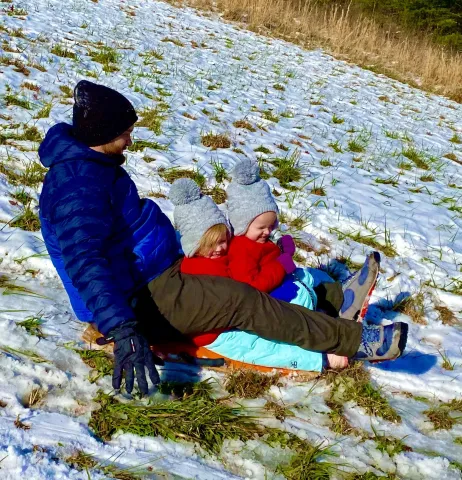Winter Dressing to Stay Outside

By: Steve Roark
Volunteer, Cumberland Gap National Park
With these harsh cold snaps we’ve been having, staying warm has become more of a challenge. Wearing the right clothing when getting outside can make all the difference between a pleasant outing and misery. The phrase "dress in layers," is used by Moms the world over, but remains good advice. Layers of clothing help trap air around the body and insulates it from the cold. Layers can also be removed to adjust to temperature changes or physical activity. Clothing layers are broken down into three parts: inner, middle, and outer.
Base layer: This is directly against your skin and needs to be comforting to the touch. The traditional inner wear is the cotton/polyester “long johns” and is okay for situations where you won't be working up a sweat. But if you are hiking, splitting wood, or doing other things that make you perspire, cotton will absorb moisture and hold it against your skin, causing you to chill or feel clammy. Modern technology has produced new breeds of underwear that wick moisture away from the skin. The most common material used is polypropylene, which works very well. It is somewhat expensive but take care of it and it will hold up for many years. Polypro underwear is available wherever sport clothing is sold, and available in several thicknesses.
Middle layer: This is your main insulating layer and needs to be thick and fluffy to trap still air. This can be anything from a flannel shirt to an insulated vest. Wool is a good choice, as it insulates even when wet. Fleece is the most widely available and is an excellent choice.
Outer layer: This is your first defense against the elements. In wet weather you want the outer layer to be waterproof. If it's windy, the material needs to be a tightly woven material, such as nylon. There are plenty of coats on the market that will do both. Make sure the hood is good quality and can be pulled tight around your face to keep out a cold wind.
Other considerations: Being hot headed is not just a metaphor. Over 40% of your body heat is lost from the head, so cover it. To me nothing beats a soft wool or polyester ski cap (I grew up calling them toboggans). When you don't need it, stuff it in a pocket. Hands and feet are the furthest away from the body furnace, so they need protection. If you don't need your fingers, mittens are best as they allow fingers to share heat. When working in water or snow, wear waterproof gloves. If you need dexterity, invest in some fingerless wood gloves. Layer your socks in cold weather. A thin polypropylene sock covered by a heavy wool sock works well. Insulated boots may be needed if you’re outside for long hours in snow or rain. A scarf or neck gaiter will help keep out bitter cold winds.
You won’t like it at first, but when you’re hiking it’s best to start off feeling cold with minimal layers. As you walk (especially uphill) your body will quickly build up heat and warm you up, whereas if you start from the car dressed warm you will soon be sweating, which is bad and can lead to chilling. One more tip: staying hydrated helps you stay warm.
- Log in to post comments